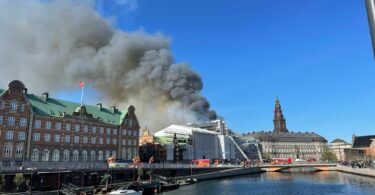
BRISTOL, Connecticut, U.S.A. — A few weeks ago, a mysterious dust cloud rolled down a second floor hallway packed with students and teachers at Bristol Central High School.
“We all saw it. It was ridiculous,” said Martha Bansavage, an English teacher. “We were exposed to it and breathing it.”
After listening to numerous faculty complaints about the thick cloud of concrete dust kicked up by construction work, the project’s architect, Jim Lawler, said that “anyone in the corridor should have been hospitalized.”
The cloud was only the most serious of a growing list of gripes about air quality from teachers and students complaining about headaches, burning eyes and sore throats.
Responding to the concerns, Central Principal Christopher Clouet recently organized a meeting between faculty members, Lawler and several construction supervisors to discuss possible health issues. Clouet allowed The Tattoo to sit in.
Teachers questioned how poor the school’s air quality is — and whether or not it poses a health risk. They also wondered about strange chemical odors seeping into classrooms.
“I’m concerned that we’re in a situation where we might not get the clean air we need,” Clouet said.
Since the session, steps have been taken to start testing the air regularly, seal off construction areas better, provide chemical information to teachers and establish a procedure for dealing quickly with complaints.
Both Central and its crosstown rival, Bristol Eastern High School, are in the midst of a lengthy $40 million renovation project to modernize the buildings.
Central’s teachers and administration were concerned that some of the construction areas were improperly sealed off from classrooms, causing the air problems that made some people ill.
Central’s school nurse, Jane Glasgow, said a couple of teachers have tied their health problems to the building by documenting the times symptoms arose.
But, she said, it’s hard to say whether other health-related complaints by teachers and students are connected to the construction, especially with flu and allergy woes so common this time of year.
Lawler said that some construction areas weren’t sealed off correctly. “Frankly, it was a problem,” he said.
He said concrete dust is probably only harmful if the dust is inhaled over long periods of time.
“It is the concentrated levels that are a problem,” said Lawler.
That’s why construction workers who deal every day with the dust wear masks to keep from breathing it in, he said.
After faculty complaints about the dust, Lawler said construction crews sealed off the areas properly.
Teachers said the problem did seem to lessen afterwards.
“I think it’s gotten better,” said Ann Norton, an English teacher.
Lawler said part of the air quality problem is caused by the school’s poor ventilation system.
Beyond that, some exhaust fans do not function properly, making the lower level locker rooms and some classrooms on the second and third floor prone to less than perfect air, Lawler said.
He said the malfunctioning fans are a maintenance issue that does not fall under his
jurisdiction.
“You do not have a real ventilation system in the majority of the building,” said Lawler.
He suggested that teachers in highly effected areas should open their windows whenever it is convenient and keep their doors shut at all times.
Lawler said a representative from the company that does air tests after asbestos removal will now also conduct random tests to make sure the air is safe.
Clouet seemed confident after the meeting that the building’s air is not a health risk, and tests should prove that.
“I think we’ll find out we’re not in a dangerous building,” he said.
At the Nov. 5 faculty session with construction experts, a lot of the discussion focused on chemical smells in the building and their possible origin.
Lawler said that, to his knowledge, there were no chemicals used on the project at this time.
A construction worker who also attended the meeting, whose name is unknown, said the company used a water-based spray paint to mark the walls while it worked, but the small amount involved shouldn’t have affected anyone.
So it remains a mystery what teachers and students are smelling.
Lawler said that Central will soon have Material Safety Data Sheets — also known as MSDSs — that provide information about the levels of hazards certain chemicals pose.
Although the sheets are meant for people who work directly with the chemicals, they will be available if there is ever a concern that someone else has been improperly exposed.
“Those are very important,” said Glasgow.
Clouet said he wanted the faculty to meet with the contractors to open lines of communication to learn the best way to have concerns addressed.
Clouet said that sometimes when the faculty brings up problems, “We get answers something like, ‘We don’t know.'”
“I don’t have anything to hide and I don’t want anything hidden from me,” he said.
Lawler agreed that there needs to be more communication.
“When there is a problem, we need to address it immediately,” he said.
Lawler told faculty members they should contact Clouet anytime they have any kind of construction-related problem. Then Clouet can contact those in charge of the job, he said, who should be able to correct it.
After the construction session, teachers were a little more optimistic.
“I did think the meeting was beneficial,” said Norton. “Now there is an avenue of communication that’s been opened.”
Glasgow said that communication is important, especially when problems arise.
“There are always going to be glitches in theplan,” she said. “At least they’re listening to us.”
Amanda Lehmert is a Reporter for Youth Journalism International.


